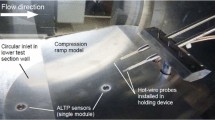Abstract
Flow blockages are used to promote the transition of a flame to a detonation. The structure of shock waves formed with different configurations of blockages was experimentally determined for subsonic incoming flow. High speed subsonic flows could develop ahead of a turbulent flame and the interaction of such flows with blockages could lead to the formation of interacting shock waves, slipstreams, and expansion waves. A blow-down test setup was designed to study the interacting shock pattern formed with different configurations of blockages. The flow was found to accelerate to low supersonic velocities during its passage over the blockages. The shock structure downstream of the blockages was found to depend on the shape, size, and number of blockages as well as the spacing between them. While a parabolic-shaped blockage provided shocks of maximum strength, large blockage ratio values did not permit the formation of shocks. The shear layer, formed in the flow downstream of the blockages, reflected the expansion fan as shock waves and was found to be a major feature influencing the formation of the interacting structure of oblique shocks. The structure and strength of the shock waves are analyzed using hodograms. The formation of the interacting family of shock waves using different configurations of blockages and the spacings between them are discussed.























Similar content being viewed by others
References
Urtiew, P.A., Oppenheim, A.K.: Experimental observations of the transition to detonation in an explosive gas. Proc. R. Soc. Lond. A 304, 13–28 (1966)
Ciccarelli, G., Dorofeev, S.: Flame acceleration and transition to detonation in ducts. Prog. Energy Combust. Sci. 34, 499–550 (2008)
Chue, R.S., Lee, J.H., Zhang, F.: Transition from fast deflagration to detonation under the influence of periodic longitudinal perturbations. Shock Waves 5(3), 159–167 (1995)
Smirnov, N.N., Nikitin, V.F., Shurekhdeli, A.A.: Investigation of self sustaining waves in metastable systems: deflagration to detonation transition. J. Propuls. Power 25(3), 593–608 (2009)
Makris, A., Shaffique, H., Lee, J.H.S., Knystautas, R.: Influence of mixture sensitivity and pore size on detonation velocities in porous media. Shock Waves 5, 89–95 (1995)
Bubkin, V.S., Korzhasin, A.A., Buner, V.A.: Propagation of premixed gaseous explosion flames in porous media. Combust. Flame 85, 181–190 (1991)
Knystautas, R., Lee, J.H.S., Shepherd, J.E., Teodorczyk, A.: Flame acceleration and transition to detonation in benzene air mixtures. Combust. Flame 115(3), 424–436 (1998)
Veser, A., Breitung, W., Dorofeev, S.B.: Run-up distances to supersonic flames in obstacle laden tubes. J. Phys. IV Fr. 12, 333–340 (2002)
Kuznetsov, M., Alekseev, V., Matsukov, I., Dorofeev, S.: DDT in a smooth tube filled with a hydrogen oxygen mixture. Shock Wave 14(3), 205–215 (2005)
Ciccarelli, Gaby, Johansen, Craig T., Parravani, Michael: The role of shock flame interactions on flame acceleration in an obstacle laden channel. Combust. Flame 157(11), 2125–2136 (2010)
Frolov, S.M.: Fast deflagration to detonation transition. Russ. J. Phys. Chem. B 2(3), 442–455 (2008)
Semenov, I., Frolov, S., Markov, V., Utkin, P.: Shock to detonation transition in tubes with shaped obstacles. In: Roy, G., Frolov, S., Sinibaldi, J. (eds.) Pulsed and Continuous Detonations, pp. 159–169. Torus Press, Moscow (2006)
Shapiro, : The Dynamics and Thermodynamics of Compressible Fluid Flow, vol. 1. Wiley, New York (1953)
Author information
Authors and Affiliations
Corresponding author
Additional information
Communicated by N. N. Smirnov.
Appendices
Appendix A: Uncertainty in the upstream Mach number
The uncertainty in the upstream Mach number is calculated for a given blockage height using stagnation and static pressure values. Stagnation and static pressures were measured at the upstream location 55 mm from the blockage. The uncertainty is between 2.7 and 4.1 % depending on the heights of the blockages used. The values of uncertainty for a nominal Mach number of 0.94, 0.89 and 0.77 corresponding to the rectangular blockage heights of 2.5, 5 and 10 mm are given in Tables 1, 2 and 3.
Appendix B: Uncertainty in the shear layer angle
The uncertainty in the shear layer angle is calculated from different schlieren images taken at different times with aerosol injected into the settling chamber. A straight line is fitted for the observed shear layer over a distance of 10 times the blockage height. The angle made by this straight line with the axis of the test section is defined as the shear layer angle. The uncertainties depend on the height of the blockages used and are between 1.33 and 13.8 %. The values are given in Tables 4 and 5.
Rights and permissions
About this article
Cite this article
Cheeda, V.K., Kumar, A. & Ramamurthi, K. Influence of shear layers on the structure of shocks formed by rectangular and parabolic blockages placed in a subsonic flow-field. Shock Waves 24, 157–169 (2014). https://doi.org/10.1007/s00193-013-0476-1
Received:
Revised:
Accepted:
Published:
Issue Date:
DOI: https://doi.org/10.1007/s00193-013-0476-1




